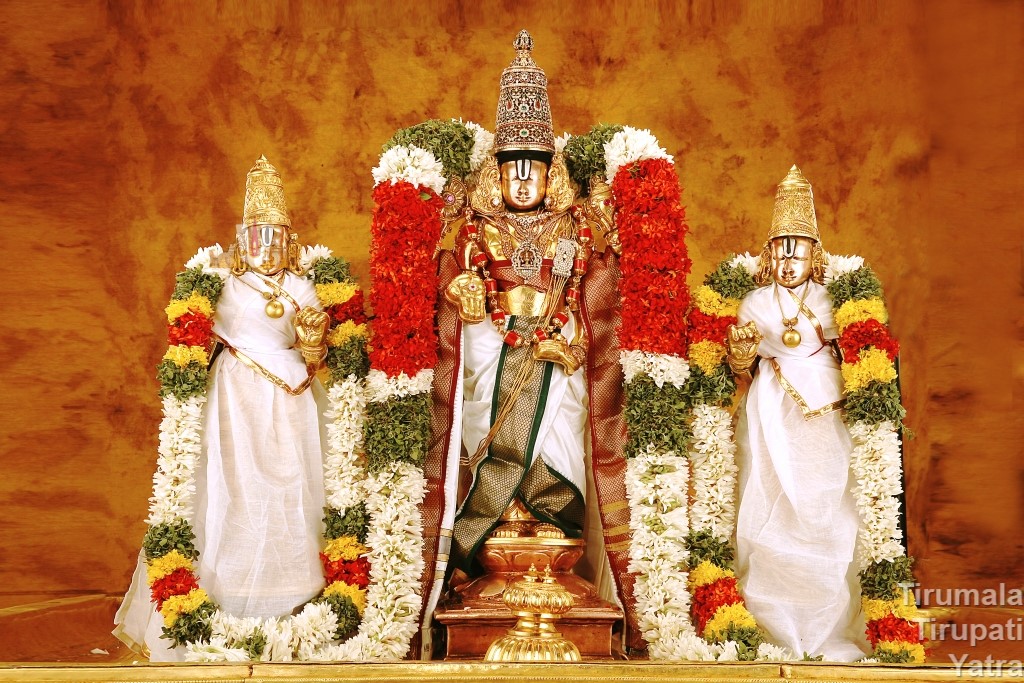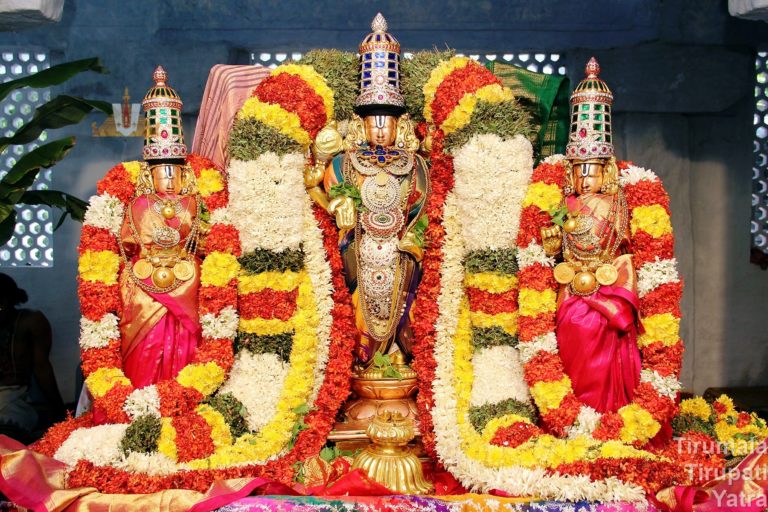Table of Contents
ToggleMalayappa Swamy
The first mention of this Deity under the name Malai Kuniya Ninra Perumal is found in an epigraph about the year 1339 A.D. The idol is in a standing pose and is a replica of the Dhruva Bera.
The two upper arms hold the Sankha and Chakra, the lower right arm is in the Varadahasta pose and the left arm in Katyavalambita pose. This image has a very rich treasury of precious gems and jewels made of platinum and gold.

About Idol
The idol of Lord Malayappa is about three feet height and stands on a lotus pedestal on a platform about 14” high.
To the right is the idol of Sridevi about 30" in height, her pedestal being about 4". This is a panchaloha idol. Her left hand is in the Kataka hasta pose, the right hand hanging loosely and the fingers held in the Gajakarna pose. Bhudevi is in a standing pose.
The only difference between her and Sridevi is that it is her right hand that is in the Katikahasta pose and her left in the Gajakarna mudra.
Sridevi idol
The idol of Sridevi is always placed on the left-hand side of Sri Malayappa Swami. The idol is 26 inches in height and stands on a 4-inch pedestal. The panchaloha idol is seen with the left hand in the Kataka hasta pose.
In this pose, the fingers are partially closed, as if holding a lotus. The right hand hangs loosely on the side and the fingers are held in the Gajakarna pose.
Bhudevi idol
The idol of Bhudevi is always seen on the right-hand side of the Malayappa Swami idol. The idol is very similar to the idol of Sridevi to signify that Sridevi and Bhudevi represent the two equal spirits of Goddess Lakshmi, the consort of Vishnu.
The only difference in the idols is the swap in the hand poses. The idol of Bhudevi has her right hand in the Kataka hasta pose and the left in Gajakarna pose. Bhudevi is regarded as the consort of Varaha, Vishnu's third incarnation.

Processional Deity
There is a legend that on one occasion during the Brahmotsava, a procession was going around the streets when a fire broke out in the village which destroyed the houses.
The archakas and the devotees did not know how this disaster happened. When sincere prayers were offered, God spoke through a man and stated that the times had changed, that the old Ugra Srinivasa who was the then Utsava murti should no longer be used as a processional deity, and that in the glades of the mountain, another Murti would be found, and only he should be used for this purpose.
It is because of this anger, that the old Murti is perhaps known as Ugramurti. Tradition is that the new Murti with His Consorts was found at a place where the hill bowed very low, and hence he was called ‘Malai Kuniya Ninra Perumal’.
This long name got shortened into Malayappan in the course of time. The glade where he is said to have been found is still known as Malayappan Konai.
Daily worship
Malayappa swami is used as the utsava murti and marriage to his consorts and post-marriage rituals are performed to the idol every day. Srivari Kalyanotsavam (Lord's marriage festival) is conducted with Sridevi and Bhudevi (goddess of the earth).
After the marriage ceremony, the lord and his consorts are seated on various vahanams (Vehicles) as part of the Arjitha Brahmotsavam. Dolotsavam seva has the Lord seated in the Addala mandapam (Mirror hall) and entertained with Vedic hyms. This is followed by serving the Lord with perfumeries, scents, and sandal paste to the vedic hyms of Purusha suktam and Sri Suktam and is followed with Abhishekam as part of the Arjitha Vasanthotsavam celebrations.
Arjitha Brahmotsavam and Vasanthotsavam functions are the abridged versions of the Brahmotsavam (9 days) and Vasanthotsavam (3 days) festivals respectively.
In the evening, the Lord and consorts are taken outside the temple as part of the Sahasra Deepalankarana Seva where he is entertained with vedic hymns and annamaya sankirtanas.
This is followed by a procession on the 4 mada streets surrounding the temple before the lord is taken back into the temple, in time for the ratripuja (night puja)
